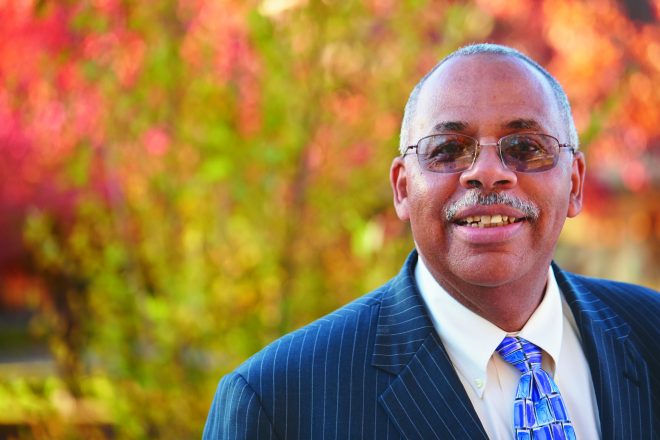 In 1990, Minnesota State Mankato hired a human resources specialist to help develop a more diverse pool of candidates for faculty and staff searches. That year, more than a dozen diverse hires were made—one of the largest classes ever at the University. One of those was a young man from New York City who was hired to be the director of Student Activities: Henry Morris.
In 1990, Minnesota State Mankato hired a human resources specialist to help develop a more diverse pool of candidates for faculty and staff searches. That year, more than a dozen diverse hires were made—one of the largest classes ever at the University. One of those was a young man from New York City who was hired to be the director of Student Activities: Henry Morris.
Morris, who became the dean for Institutional Diversity in 2013, is the only one of those hires still at the University. “Twenty-five and a half years later and I’m still here,” he laughs. “I thought I’d be here for three years, but every time I started to think about leaving, they would make it more interesting for me.”
His decision to stay has given Morris a unique perspective on how diversity at Minnesota State Mankato has changed in the past quarter century—and on the important work that still needs to done.
Q: What are the most significant ways the University has changed since you started in 1990?
A: We are more intentional about what we do. We’re talking more often about the recruitment and retention of faculty, staff and students. I meet regularly with the director of Human Resources and the director of Equal Opportunity and Title IX, I speak with the cabinet and the Council of Deans.
Q: What has Minnesota State Mankato done right?
A: We were one of the first in the state, and in the nation, to have a chief diversity office, with Dr. Mike Fagin becoming an associate vice president in 1990. He served on the President’s Cabinet—and we were ahead of the curve on that. That’s one of the good things here, that we have a structure set up for this. And we have for a long time. We were one of the first to have a cabinet level position. We were one of the first to have a LGBT Center, a Women’s Center and a Multi-Cultural Center, all staffed by full-time people. A lot of my colleagues here in Minnesota see us as a model for what diversity should look like, in terms of staff and resources. Right now we have 17 full-time staff working in diversity; you won’t find that anywhere else in the MnSCU system, or even at the University of Minnesota. Those are all things we can hold our heads high about.
Q: What kind of results are we seeing from the investment in resources and staff, especially in terms of recruitment?
A: We are doing a much better job with recruiting. When I first came, 5 percent of the student body was students of color. Now we’re at 17 percent. So we’ve definitely grown.
Q: Issues of race and equality have been discussed at many college campuses this year—including Minnesota State Mankato. What has been going on here?
A: Conversations have been happening here. Students have been sharing concerns with me and with senior leaders. They raise concerns about increasing the number of diverse students, increasing the number of diverse faculty and staff. They share stories with me. The issues are not new, but sometimes you need a critical mass to start a movement. They need to know it isn’t just them, that it’s bigger than that.
Q: Has the University responded appropriately to the students’ questions and concerns?
A: One of the biggest issues is that students need to believe that their voices are being heard by school leaders. There’s no need to do a sit-in if they know that they have access to those leaders. It’s important to the students that we hear what they are saying and acknowledge it as true. And I think right now they do feel that way. We’ve had open forums with the President. The President had dinner with student leaders. As we move forward, I think it’s clear that the President and other administrators are trying to hear what they have to say.
Speak Your Mind